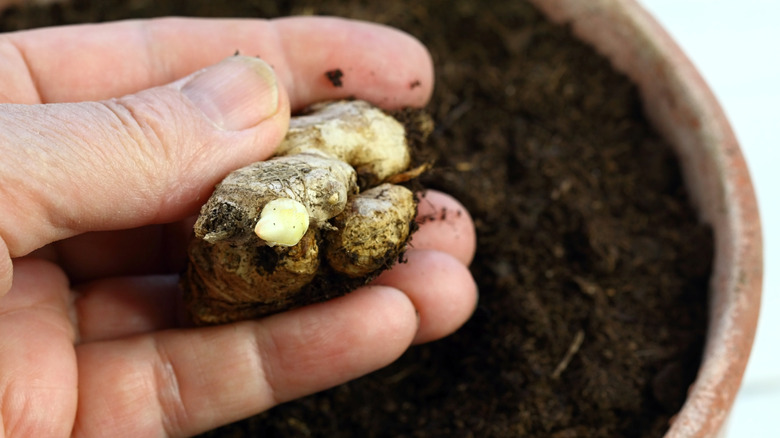How To Grow Ginger Indoors For Year-Round Harvests
Ancient Chinese and Ayurvedic texts praised ginger long before it became a kitchen staple. They called it "universal medicine" for its ability to soothe a sore throat and calm the stomach. However, today, it's mostly treated as a spice you buy, not something you can grow — and that's where most people miss out. Despite thriving in tropical rainforests, ginger is perfect for growing indoors and in small spaces. All you need is a healthy rhizome from a reputable nursery, since most store-bought ginger has been sprayed with growth inhibitors to make it last longer on the shelf. While this is great for supermarkets, it's terrible for gardeners. Although it is believed that soaking them in warm water for about two hours can help shed these inhibitors, it's best to opt for organic ginger to ensure it sprouts.
Cut your ginger root into 1½-inch chunks with at least two buds or "eyes" each. Let those pieces rest for a few days, so they can heal before you plant them. Once the rhizomes form calluses, grab a tray or a shallow pot to plant them in. Then, prepare your soil for successful planting. Ideally, opt for a well-draining soil. Bury the ginger about 2 inches below the surface, with the buds facing upward, so shoots can grow freely. Then, store the container somewhere cozy. The soil must stay warmer than 55 degrees Fahrenheit for ginger to grow well. Continue watering lightly to keep the soil moist, and in about eight weeks, sometimes longer, those green shoots will appear.
Tips to keep your indoor ginger thriving
When you finally see sprouts pushing through the soil, that's your cue to move your ginger plant into its permanent pot. At the time of potting, mix in a slow-release fertilizer, but avoid adding too much at once; just enough to keep it fed and happy over time. Ginger is a slow-and-steady grower, and this kind of fertilizer keeps its roots energized without overwhelming them.
Be sure to avoid the common mistakes everyone makes when growing ginger, such as overwatering. Ginger loves moisture but despises being waterlogged. So, balance is everything. Keep the soil lightly moist, and don't let it turn bone-dry. You can check this by touching it. If the soil feels dry an inch down, it's time to water. And remember, ginger thrives in mildly acidic soil, so a pH between 5.5 and 6.5 keeps it perfectly grounded. Place the pot in a location that receives bright, indirect light. In case you choose to move your pot outside during warmer months, pick a spot with some shade to keep it from getting scorched.
When your plant matures and those green stalks begin to yellow, that's nature's way of saying it's ready. Harvest gently by digging up the rhizome and giving it a good wash. Let it dry completely before storing it in a cool, dry place. Or, if you love convenience, pop it in the freezer. That way, you can grate a little spicy zing whenever your tea or stir-fry needs a soulful touch.

